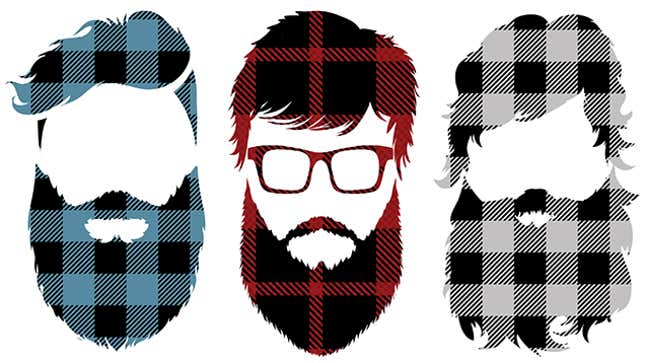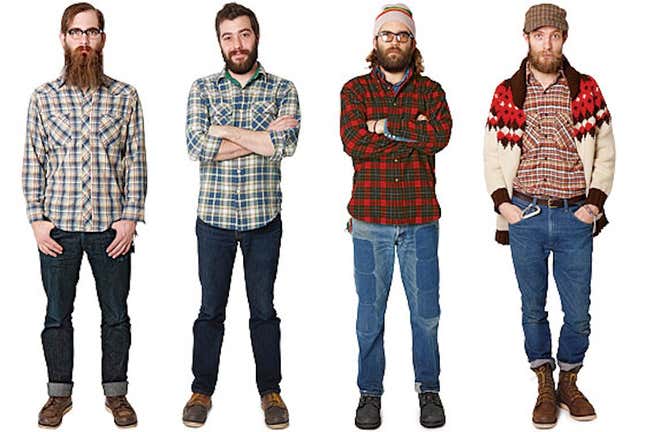Who Is the Lumbersexual and Is Anything About Him Real?
Latest

If you were alert last week and in possession of even the shiftiest wifi, you know about the latest costume trend in men’s attire: the Lumbersexual.
Said to have emerged brawny and glistening from last decade’s zeitgeist, with the blood of the Metrosexual on his hands, the Lumbersexual tempts us all with his big, hard, manly, robust, woodsy sense of style. But is he all he’s chopped up to be?
Let’s examine what’s purportedly going on with this plaid-flannel-clad contender lumbering sexually into our hearts.
What is a Lumbersexual, anyway?
Just over a week ago, Tom Puzak at GearJunkie penned “The Rise of the Lumbersexual,” and put it thusly:
Today, the metrosexual is a disappearing breed being quickly replaced by men more concerned with existing in the outdoors, or the pseudo-outdoors, than meticulous grooming habits.
He is bar-hopping, but he looks like he could fell a Norway Pine.
He looks like a man of the woods, but works at The Nerdery, programming for a healthy salary and benefits. His backpack carries a MacBook Air, but looks like it should carry a lumberjack’s axe.
He is the Lumbersexual.

(via)
Puzak suggests that perhaps this business is all about a renewed interest in environmentalism, or indicative of the shift away from the traditional 9-to-5 office gig. Also, that there is a “beginner’s end” on the Lumbersexual spectrum that might be represented by, say, Ryan Gosling in RedWing work boots carrying a leather Jansport Pleastanton backpack, like so.
He suggests this “cleaner” version of the look (less scruff, less rumple) could be called the MetroJack.

Puzak:
He might be wearing a Patagonia heritage jacket, or some technical Cordura nylon pants that look great in the low light of the bar, but also provide protection from a chain-saw blade.
Yes, the rusty chain-saw blade he bought at a flea market to hang over his desktop Mac.
Then, there is the “Advanced Lumbersexual,” who, Puzak writes, “looks like a hardened outdoorsman but his flannel feels soft to the touch. He will open your beer with an omni-present Buck knife. He is a master of the retro Instagram filter. His flannel is coated with a waterproof DWR coating. His laid back style has been honed with more effort than he would like you to know.”
The internet sailed forth and spread the term from the remaining unfelled treetops, heartened by the news that there was a readily identifiable New Type of Man. BoldItalic did a follow-up piece, where Peter Lawrence Kane accepted the term while keeping a certain professional distance:
It goes without saying that virtually no man ever called himself a metrosexual, which really just referred to men who shopped for their own pants, went to the gym, and used moisturizer. (That was a big leap. It really was.) So don’t expect the term Lumbersexual to blow up, no matter how ubiquitous Lumbersexuals become.
Around the time that men who previously just thought of themselves as “men” began thinking of themselves as “straight men,” some other things happened. It became more acceptable to care about your appearance and read some magazines to that effect than before. And straight guys hug each other a lot more than they used to, which is great. This move back to a more overtly masculine style — which like metrosexuality, is still consumption-based — builds on that, rather than canceling it out. Who wouldn’t want a beer and a warm embrace after felling some timber?
But is the Lumbersexual for real, or just a weirdly modern attempt to nod to cues of masculinity without any of the actual skills required to get the job done?
Point:
Lumberjack is at least a fresh new term for the modern man, and what’s more, an uncontroversial one. It’s a term for a man who, for many, looks like a man “should look” and acts like a man “should act,” i.e., an identity that doesn’t require that much grooming. The term is way less fraught than Metrosexual, which for a lot of people was still just synonymous with “gay.”
Counterpoint:
The term already exists. It’s called “Urban Woodsman.”
Point:
Hypermasculinity of this sort symbolizes resourcefulness and strength, two fine qualities that are desirable in any person, particularly a man person, so people say.
Counterpoint:
The lumbersexual may work in marketing. He doesn’t even know how Zippos work.
Point:
Everyone likes the strong, silent type.
Counterpoint:
The strong, silent lumbersexual is likely to be drowning his feelings in craft beer and it is killing him (and his bank account).
Point:
The objectification is liberating. Beards are sexy. Peak beard is a myth. Men should cast off oppressive grooming standards and embrace their facial hair.
Counterpoint:
Emblematic of confused state of masculinity today. As a comedian I know puts it, men today have full beards but shaved balls. “Folksy on the face, creepy on the balls.”
Point:
The lumbersexual exhibits a comfortable swagger. Soft flannel and aggressively durable work boots suggest he’s out there, looking good and working hard.
Counterpoint:
This surface covers a modern type of cowardice. The lumbersexual is working hard all right—at home, jacking off to free porn directly into that soft flannel while wearing very attractive $350 selvedge jeans.
Point:
Looks like he can chop some wood on a cold night.
Counterpoint:
Hasn’t actually been near raw wood since summer camp.
Point:
Rugged individualism is written into the backbone of the lumberjack mythology.
Counterpoint:
The whole thing smacks of a trendy joiner mentality.
In conclusion, it’s a nice look, but somewhat misleading—reading these pieces feels like meeting a retro sexy librarian type who isn’t actually into books. With the Lumbersexual, the very things that might draw to you such a manly dressed man are likely to disappoint when you discover he won’t be building a campfire, crafting some bookshelves, or investigating that weird noise outside the tent.
But hey, fashion is fashion. And the lumberjack look is still pretty hot, right?
Illustration by Tara Jacoby.